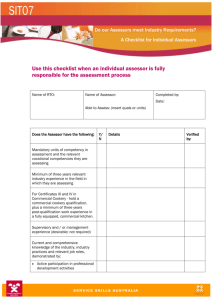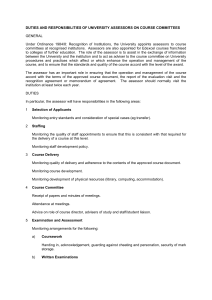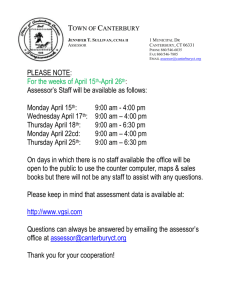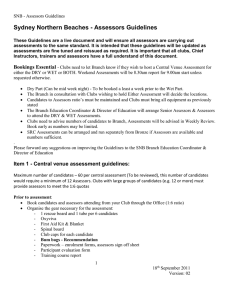Assessment Center Slides
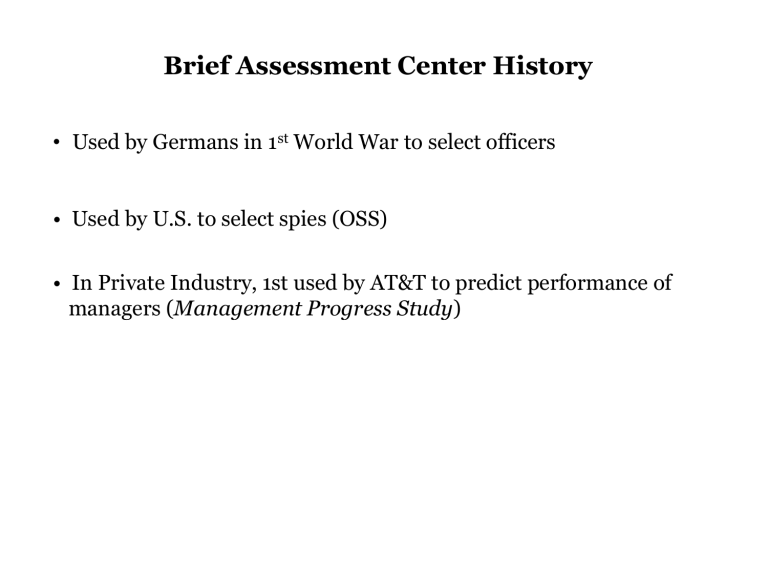
Brief Assessment Center History
• Used by Germans in 1 st World War to select officers
• Used by U.S. to select spies (OSS)
• In Private Industry, 1st used by AT&T to predict performance of managers (Management Progress Study)
AT&T Manager Progress Study
• 1 st application of AC method in US industry (Douglas Bray)
• Longitudinal study of 400+ recently hired managers
• Inbasket, LGD, manufacturing game, interview, personal history, p&p tests (g & personality)
• Predicted progress over a 15 year period
• Implemented throughout the whole Bell system
From then to now…
• 1960s: AT&T shared…
– IBM, Sears, Standard Oil, GE, J.C. Penny
• 1966: Bray & Grant: Psych Monographs Paper
• 1969: Conferences being held on AC Method
• 1970: Byham article in Harvard Business Review
• 1973: 1 st International Conference on Assessment Center Methods (ICACM )
Meeting; DDI Established
• 1975: AC Guidelines Published
• Today: Hundreds of studies, Thousands of ACs conducted, Millions Assessed!
Uses of the Assessment Center Method
• Selection and Promotion
• Diagnosis
– Identification of training & developmental needs
• Development
– Skill enhancement through simulations
– Not the same as diagnosis
(Carrick & Williams, 1999)
Assessment Center Defined
• An assessment center consists of a standardized evaluation of behavior based on
multiple inputs
.
Multiple trained observers and techniques
are used. Judgments about behaviors are made, in major part, from specifically developed assessment
simulations
. These
judgments are pooled
in a meeting among the assessors or by a statistical integration process.
- International Taskforce, 2009
The AC Big “10”…
1. Job analysis (behaviors)
2. Behavioral classification (dimensions)
3. Links: behaviors dimensions exercises
4. Multiple assessments
5. Simulations
6. Multiple assessors
7. Assessor training
8. Recording behavior
9. Reports
10. Data integration
Observation Rating Judgment
Assessor Training
• Orientation to the method
• Frame of reference training on the dimensions (Schleicher, 2002)
• Training on common rating errors (Thornton & Rupp, 2005)
• Role player training (International Taskforce, 2009)
• Familiarity with stimuli materials and rating process (Leivens,
2001)
• Practice! (International Taskforce, 2009)
Sample of a “Full-Blown” Assessment Center
S
Assessors and
Candidates
Arrive;
Review AC
Schedule
M
AC Day;
Exercises
Conducted
Evening
Assessors
Review
Notes and
Score
Assigned
Candidates
T
Group
Discussion of Assigned
Candidates
W
Group
Discussion of Assigned
Candidates
TR
Group
Discussion of Assigned
Candidates
Evening
Assessors
Review
Notes and
Score
Assigned
Candidates
Evening
Assessors
Review
Notes and
Score
Assigned
Candidates
Evening
Write
Summary
Report on
Assigned
Candidates
F
Submit
Final
Summary
Reports
Assessment Center Exercises
Sample Individual Exercises
• Interview Simulation
• Scheduling Exercise
• In-Basket
Sample Group Exercises
• Leaderless Group Discussion
• Business Game
1. Decisiveness
Dimensions By Exercise Grid
Interview
Simulation
X
Scheduling
Exercise
Business
Game
(X)
Leaderless
Group
Discussion
(X)
2. Leadership
3. Management
Control
4. Oral
Communication
5. Planning and
Organization
6. Problem
Analysis/Judgment
7. Resilience
8. Sensitivity
9.
Written
Communication
(Reaction Forms)
(X)
X
(X)
X
(X)
(X)
(X)
X
X
(X)
(X)
(X)
X
X
(X)
X
X
X
(X)
X
X
X
(X)
(X)
X
X
X
X
To be measured in four Participant Reaction Forms
X Quality typically measurable in this particular exercise
( ) Parentheses indicate an exercise that is a particularly strong measure of that quality
Participant:______________
(Name)
Assessor: ______________
(Name)
Date: ____________
Assessor Report Form
Interview Simulation
1 – Very little or none of the quality was shown.
2 – A less than satisfactory degree was shown.
3 – A satisfactory amount was shown.
4 – A greater than satisfactory amount was shown.
5 – A great deal of the quality was shown.
(1) Decisiveness:
(Readiness to make decisions, render judgments, take action or commit oneself.)
(2) Judgment:
(Ability to develop alternative solutions to problems, to evaluate courses of action and reach logical decisions.)
______
______
Assessor Discussion Form
Assessors:
_____________________________ Participant:_______________________
_____________________________ Date: ______________
_____________________________
Decisiveness:
Readiness to make decisions, render judgments, take action or commit oneself.
Business Game
Interview Simulation
Leaderless Group Discussion
Assessor Your
_____ _____
_____ _____
_____ _____
_____ _____
Overall _________
Initiative:
Actively influencing events rather than passively accepting; self-starting. Takes action beyond what is necessarily called for. Originates actions rather than just responding.
Business Game
Leaderless Group Discussion
A ssessor Your
_____ _____
_____ _____
Overall _________
Assessment
Center ---
Sample
Final Rating
Form
Dimension
Decisiveness
Initiative
Judgment
Leadership
Management
Control
Oral
Communication
Planning &
Organization
Problem
Analysis
Resilience
Assessor #1
Sensitivity
Written
Communication
Overall Score
Assessor #2 Assessor #3 Final Rating
Data Integration Options
• Group Discussion
– Administrator role is critical
– Leads to higher-quality assessor evidence—peer pressure
– Beware of process losses!
• Statistical/Mechanical
– May be more or less acceptable to organizational decision makers, depending on particular circumstances
– Can be more effective than “clinical” model
– Requires research base to develop formula
• Combination of both
– Example: consensus on dimension profile, statistical rule to determine overall assessment rating
Behavioral Focus
Assessment Center Pros and Cons
Pros
Multiple exercises and raters
Cons
Time and money involved (Cascio &
Ramos, 1984, N > 600 managers =
$688.00/person. Inflation adjusted = over
$1,500.00/person)
Potential biases during group discussion
Legal compliance
Less adverse impact than cognitive ability
Better predictor of progression within organizations than specific performance scores
(Policy Capturing Device?)
Liked by candidates
Male-Female Differences
Source: Dean, Bobko, & Roth (2008). JAP, 93 , 685-91.
~ Assessment Center ~
International Application Issues
• Relevance and generalization of situational exercises
• Scoring of candidate behaviors
• Linkage between behaviors and a given construct (dimensions)
Example: Disagreeing with supervisor and defending one’s position in a meeting with others present (assertiveness vs. impolite)
• Criterion-related validity across cultures


